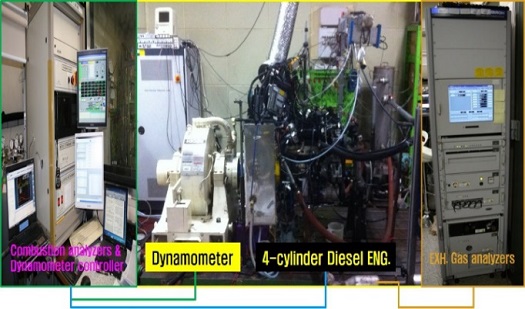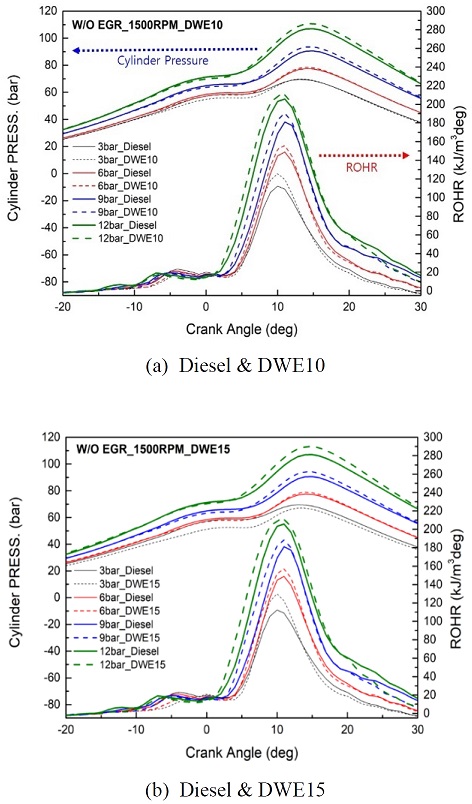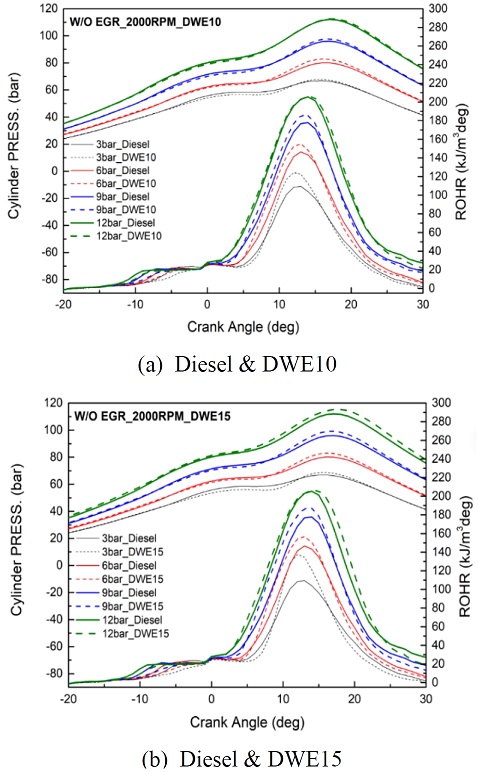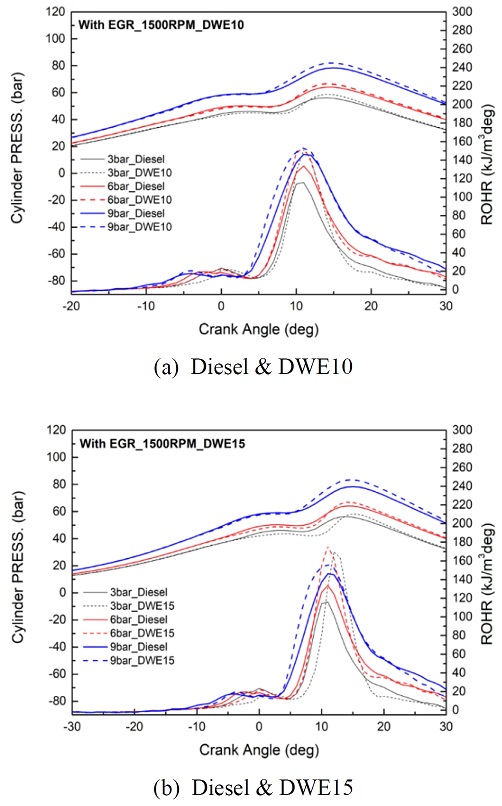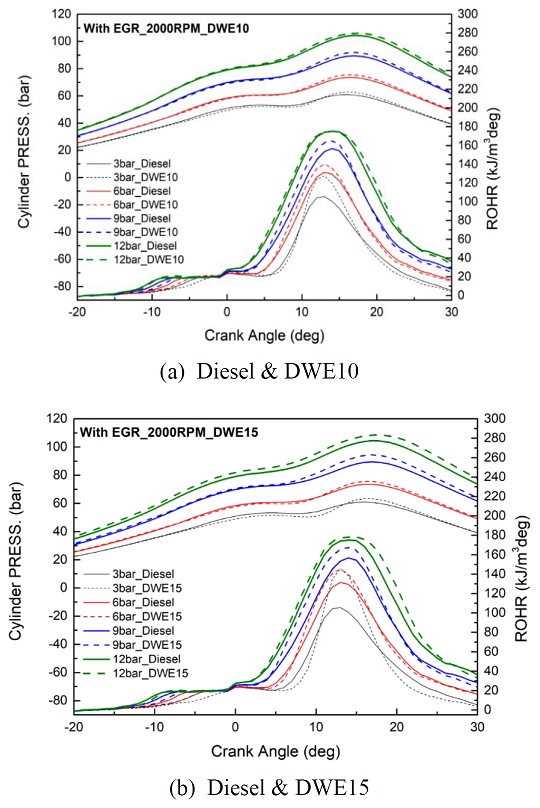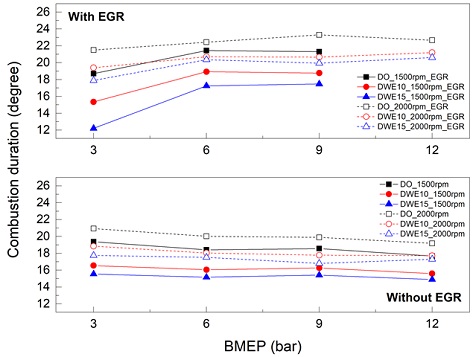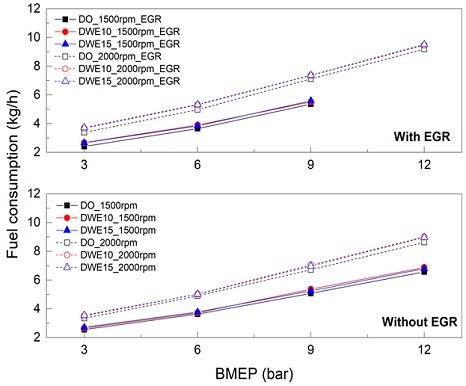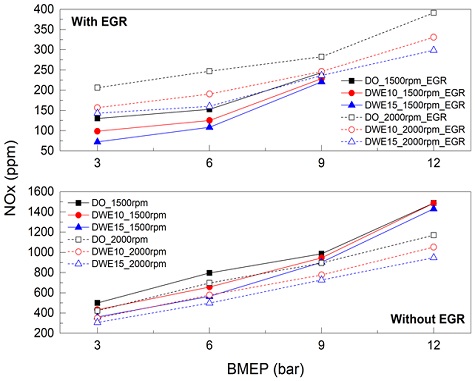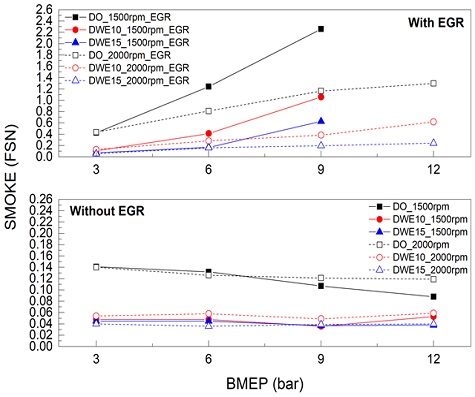
Study on effects of combustion and exhaust of diesel fuel and diesel water emulsion fuel according to exhaust gas recirculation application in diesel engine
Copyright © The Korean Society of Marine Engineering
This is an Open Access article distributed under the terms of the Creative Commons Attribution Non-Commercial License (http://creativecommons.org/licenses/by-nc/3.0), which permits unrestricted non-commercial use, distribution, and reproduction in any medium, provided the original work is properly cited.
Abstract
As regulations on exhaust gas emitted from all industrial fields are being strengthened, technologies for reducing harmful gases, such as nitrogen oxides (NOx) and particulate matter (PM), emitted from high-efficiency diesel engines used as various power sources, are being developed and applied. Post-treatment technologies, such as selective catalytic reduction (SCR), and diesel particle filter (DPF) are generally applied, but they are not easy to implement in agriculture and fishery sectors and others due to system modification and considerable cost. Therefore, in this study, we confirmed the applicability of diesel emulsion fuel, which does not require a separate additional system, and could simultaneously reduce NOx and PM by identifying combustion and exhaust characteristics, based on exhaust gas recirculation (EGR) application in a commercial diesel engine. Compared to diesel oil (DO), the NOx emission from diesel-water emulsion (DWE) was lesser by 15.9% under the condition without EGR, and by 22.3% under the condition with EGR; and the smoke emission from DWE was lesser by 62.1% under the condition without EGR, and by 73.0% under the condition with EGR.
Keywords:
Diesel fuel, Diesel water emulsion fuel, Diesel engine, Nitrogen oxides, Particulate matter1. Introduction
As the seriousness of environmental problems such as environmental pollution and climate change is emerging, the regulations on exhaust gas emitted from economic activities have gradually expanded and strengthened in all industrial fields. Diesel engines are used in various industries due to their high thermal efficiency, excellent fuel efficiency and applicability, and easy maintenance. However, they emit harmful exhaust gases such as nitrogen oxide (NOx) and particulate matter (PM), which are characterized by ignition at high-temperature, and high-pressure compression. Accordingly, there is a necessity for a solution that reduces the harmful emissions, without compromising the high fuel efficiency, to satisfy each regulation.
As the emission regulations of the automobile industry among transportation methods have been prepared and implemented in the lead, related technologies have been rapidly developed and applied to respond to these regulations. Examples of harmful emission reduction technologies include engine components technologies such as exhaust gas recirculation (EGR), combustion improvement technology such as homogeneous charge compression ignition (HCCI), post-processing technologies such as lean NOx trap (LNT), selective catalytic reduction (SCR), diesel particle filter (DPF), diesel oxidation catalyst (DOC), and alternative fuel technologies such as biofuels, dimethyl ether (DME), and water emulsion fuels to fundamentally replace fuels.
In the case of ships, exhaust gas regulations are being strengthened based on large ships and ocean-going ships, and they have carried out the verification of combustion control technologies such as EGR applied to the engine, techniques for applying post-treatment technologies such as SCR, and alternative fuel technologies such as LNG and LPG are being developed and applied. However, it is difficult to realistically respond quickly to the application and response of regulations in fields such as coastal ships, small ships, and fishing vessels, as well as agriculture and fisheries; and in the characteristic of engine operating environment, there is a necessity for a technique to reduce harmful emissions that can be used in existing diesel engines without requiring additional systems and modification, and without the burden of related costs for applying hazardous emission reduction technology.
Some alternative fuel technologies can be applied without adding to, or changing the existing system, and studies are being conducted to overcome disadvantages such as lower power and fuel efficiency, fuel viscosity, and lubrication problems, to apply them to commercial engines [1][2].
Among the alternative fuel technologies, water emulsion fuel is produced by adding emulsifiers to the water and fuel combination that do not mix with each other due to the difference in their specific gravities, and result in a state where one type of liquid is dispersed (as fine particles) in a certain proportion in the other liquid. There are two major types of water emulsion fuel: water-in-oil type (W/O), in which the water is dispersed in fuel, and oil-in-water type (O/W), in which the fuel is dispersed in water. A study on applying the emulsion fuel of water-in-oil type (W/O) to diesel engines was conducted to minimize the negative effects of corrosion, high density, etc. [3]-[5].
Water emulsion fuel is used to aid complete combustion through fuel atomizing fuel, due to micro-explosions caused by rapid evaporation of water during the compression stroke after fuel injection. It is feasible for reducing soot and NOx simultaneously by absorbing combustion heat generated due to the latent heat of evaporation of the water vaporization during the combustion process, and lowering the combustion temperature [6]-[10]. Additionally, since it can be used in a diesel engine without a separate modification or additional system, research on this type of fuel has been attracting attention [7]-[11].
In this study, after identifying the properties of diesel water emulsion(DWE) fuel of the W/O type manufactured using an ultrasonic homogenizer through component analysis, and by applying automotive diesel oil(DO) and DWE fuel to commercial diesel engines, the changes in combustion and exhaust characteristics according to EGR application were compared, and analyzed to determine their applicability.
2. Experimental Apparatus and Method
2.1 Experimental setup
The test engine was a 4-cylinder diesel engine used in automobiles, equipped with a common rail and a variable-geometry turbocharger (VGT). Table 1 lists the detailed specifications of the engine.
Figure 1 shows the configuration of the system used to verify the characteristics of combustion and exhaust of DO and DWE, and Figure 2 shows a photograph of the experimental apparatus including the test engine equipped on the engine dynamometer for engine performance analysis.
The characteristics of combustion were analyzed using the crank angle (CA) signal from the encoder equipped on the engine crankshaft, and the combustion pressure signal from the Kistler pressure sensor equipped in the glow plug hole of NO.1 cylinder, through a combustion analyzer, and the exhaust gas data were obtained using an exhaust gas analyzer.
Table 2 lists the specifications of the eddy current (EC) dynamometer, and Table 3 lists the specifications of the exhaust gas analyzer. The exhaust temperature was measured by installing a temperature sensor at the rear end of the VGT.
Additionally, the fuel line was composed of a filter without an oil-water separation function to avoid water separation from the emulsion, because the established standard fuel filter has an oil-water separation function, and the fuel consumption was measured using a mass flow meter.
2.2 Experimental method
DO was diesel oil used for automobiles, and DWE of W/O type was produced by volume, using an ultrasonic homogenizer, by adding an emulsifier up to 1% or less. To understand the change according to the water content, DWE was prepared with a water content of 10 vol.% (DWE10), and 15 vol.% (DWE15).
The properties of DO and DWE10 fuel were analyzed through an accredited certification body, and the results are shown in Table 4.
As shown in Table 4, as the DWE is a fuel containing water, C decreased by 20%, and H decreased by 17%, and the calorific value was reduced by 12%, depending on the water content compared to DO. Conversely, the density increased by 2%, and the kinematic viscosity increased by 36%, according to the water content compared to DO. It was estimated that the change in the properties of DWE according to the water content could affect engine combustion.
The engine performance test conditions were selected to cover the maximum torque performance section, and the RPM and load conditions frequently used in actual driving, to understand the combustion characteristics of DO and DWE. The engine was controlled using ETAS (ES592.1 & INCA 7.0) equipment. In the condition without EGR, the EGR rate was controlled to 0%, to prevent exhaust gas from entering the combustion chamber, and the in the condition with EGR, the EGR rate was not forced to be controlled according to the manufacturer's program settings.
Table 5 lists the engine test conditions.
The experimental case with a BMEP of 12 bar at 1500 rpm under the condition with EGR, was excluded from the experimental condition because the EGR rate continued to fluctuate, and the difference between DO and DWE was large. Table 6 lists the EGR rates under the experimental conditions. The difference in EGR rates of DO, DWE10, and DWE15 according to each rpm and BMEP conditions was not significantly, and was within 1.7%.
The coolant temperature was maintained constant at 80℃ and the fuel temperature was maintained at 40℃ after warm-up. The average value of 10 times of data was obtained when exhaust temperature, NOx, smoke, fuel flow, etc. were secure, and the reliability of the data was stabilized by repeating this 10 times again.
3. Results and Discussion
Figures 3 and 4 show the graphs comparing the combustion pressure and rate of heat release (ROHR) of DO and DWE (a: DWE10, b: DWE15), under the loads of 1500 rpm and 2000 rpm, in the condition without EGR.
For the ROHR under BMEP 3 and 6 bar conditions, in the case of DWE, the heat generation of the main injection was delayed, or similar to that of DO, depending on the water content, but the combustion was sharper than that of DO. The combustion of the fuel injected into the pilot became insignificant or delayed because of the water contained in the DWE; simultaneously, as the main injection occurred, the fuel was atomized due to the evaporation of water and consequent micro-explosions, and the combustion was promoted due to improved mixing with air. Therefore, the combustion of DWE was observed to occur more rapidly than that of DO [12][13].
Unlike the BMEP 3 and 6 bar conditions, the trend of the ROHR for the BMEP 9 and 12 bar conditions was that the ignition delay of the main fuel had advanced according to the water content of DWE, compared to that of the DO. Under the conditions of low RPM, the ignition delay at BMEP 3 and 6 bar occurred because the concentration of fuel required for ignition was low. However, in the BMEP 9 and 12 bar conditions, it was inferred that the difference between the low and high loads occurred because the fuel concentration was at a level that could be ignited by a relatively increased injection amount. From these results, it was inferred that further studies on ignition delay due to water content and appropriate fuel concentration are needed.
With regard to the combustion pressure and ROHR, DWE was higher compared with DO in the main combustion section, and the combustion pressure increased as the water content increased. It was reasoned that combustion pressure and ROHR were high because combustion was improved by the enhanced uniformity of fuel mixing with oxygen, and atomization of fuel via micro-explosions due to the evaporation of water contained in the DWE [4][11][14][15].
Figures 5 and 6 show the graphs comparing the combustion pressure and ROHR of DO and DWE (a: DWE10, b: DWE15), at 1500 rpm and 2000 rpm, in the condition with EGR.
With regard to the combustion pressure and ROHR under the test condition with EGR, the results were similar to that of the condition without EGR. DWE was higher than DO in the main combustion section, and the combustion pressure tended to increase as the water content increased.
The trend of ROHR in the condition of BMEP 3 and 6 bar was similar to that of the condition without EGR, but the ignition delay duration was relatively longer.
In the condition with EGR, in the main combustion section of 1500 rpm, the maximum ROHR for BMEP 3 and 6 bar was similar to that of BMEP 9 bar for DWE 10, and was higher than BMEP 9 bar for DWE 15. This was because the oxygen concentration was diluted by the exhaust gas flowing into the combustion chamber due to EGR, and ignition of the fuel injected into the pilot was delayed. Additionally, depending on the water content, ignition was delayed because of the latent heat of evaporation and lower fuel concentration, and it was inferred that the ROHR rapidly increased as combustion was promoted by the atomization of fuel by water, together with unburned fuel injected into the pilot during the main fuel injection.
In all the experimental conditions without EGR and with EGR, there were no issues such as the operation state of the fuel pump, engine start-up, vibration, etc., and there were no problems during the combustion of DWE in conventional commercial engine systems.
Figure 7 shows the graph comparing the combustion durations of DO and DWE. Considering the error rate from the ROHR, 10-90% of the mass burned fraction (MBF) was used as the combustion duration [10][16][17].
With regard to the condition without EGR, the combustion duration was shortened by 11.2% for DWE10, and 15.4% for DWE15 compared to that of DO. With regard to the condition with EGR, the combustion duration was shortened by 11.3% for DWE10, and 18.2% for DWE15 compared to that of DO. It was determined that the combustion duration was shortened by the promotion of homogeneous and rapid combustion, as the fuel was atomized and evenly distributed in the combustion chamber because of the micro-explosions of water contained in the DWE.
Figure 8 shows the graph comparing DWE and DO consumption, excepting water content.
The pure fuel consumption of DWE increased by 4.2% for DWE10, and 4.3% for DWE15 compared to that of DO without EGR. With regard to the condition with EGR, the pure fuel consumption of DWE10 increased by 6.0%, and DWE15 increased by 6.4% compared to that of DO. It was determined that the fuel consumption was increased because the strategy of fuel injection and combustion was not optimized according to the change in properties, such as the decrease in calorific value and increase in density and viscosity, due to the water contained in DWE. Under the condition of with EGR, the oxygen concentration was diluted because of the exhaust gas flowing into the combustion chamber. Hence, fuel consumption was considered to increase with EGR, compared to the condition without EGR.
Figure 9 shows the graph comparing exhaust gas temperatures of DO and DWE.
In the condition without EGR, the exhaust gas temperature of DWE10 was 3.0% lower, and DWE15 was 4.6% lower than that of DO. Under the condition with EGR, the exhaust gas temperature of DWE10 was 5.6% lower, and DWE15 was 6.9% lower than that of DO. Moreover, for DWE15, the reduction rate of exhaust gas temperature increased as the load increased. Therefore, it was confirmed that the water contained in the DWE absorbed the heat from the combustion chamber as it vaporized, thereby lowering the combustion temperature, and thus reducing the exhaust temperature.
Figure 10 shows the graph comparing the NOx emissions of DO and DWE. In the condition without EGR, the NOx emissions from DWE10 was lesser by 11.6%, and from DWE15 was lesser by 20.3% compared to that from DO. Under the condition with EGR, the NOx emissions from DWE10 were lesser by 17.5%, and from DWE15 was lesser by 27.0% compared to that from DO. This indicated that the NOx reduction rate was higher for the higher water content of each fuel. As a result of the exhaust gas temperature, the latent heat of evaporation of water contained in DWE absorbed the heat during combustion, thus reducing the combustion temperature. Additionally, it was determined that the NOx emission was reduced as the NOx generation conditions and duration were reduced, because the combustion duration was shortened due to the promotion of combustion by the atomization of fuel according because of the micro-explosions of water contained in the DWE. [6]-[10].
Figure 11 shows the graph comparing the smoke emission of DO and DWE.
In the condition without EGR, the smoke emission from DWE10 was lesser by 57.6% on average, and from DWE15 was lesser by 66.7% compared to that from DO. In the condition with EGR, the smoke emission from DWE10 was lesser by 64.3%, and from DWE15 was lesser by 81.7% compared to that from DO. It was determined that smoke was significantly reduced because combustion was promoted by the atomization of fuel particles by evaporation of water and the consequent rapid micro-explosion, expansion of the volume of spray, increase in flame diffusion speed, and increase in the swirl of air in the spray [4].
When comparing the results of the condition without EGR and with EGR in the results of Figure 10 and 11, except for 1500 rpm and BMEP 12 bar conditions, when EGR was applied, NOx from DO was lesser by 70.8%, but smoke was greater by 883%. Thus, it could be concluded that NOx decreased due to exhaust gas recirculating to the combustion chamber, but the smoke increased due to an increase in incomplete combustion. Comparing the results of DO under the condition without EGR, with DWE10 and DWE15 under the condition with EGR, NOx was lesser by 74.8% for DWE 10, and 77.3% for DWE 15, but smoke was greater by 337.4% for DWE10, and 172.0% for DWE15. Hence, it could be confirmed that EGR had a large NOx reduction effect, but sharply increased smoke emission, and DWE had a NOx reduction effect, but a greater smoke reduction effect.
Therefore, it was determined that the simultaneous reduction of NOx and PM could be improved by optimizing DWE with an appropriate water content, and simultaneously applying EGR to the engine to compensate for the increase in smoke emission caused by EGR application.
4. Conclusion
In this study, we applied a DWE of W/O type, and DO to a 4-cylinder diesel engine, and identified the basic combustion and exhaust characteristics in the test conditions with and without EGR. The following conclusions were drawn from the experimental results:
- 1. With regard to combustion pressure and ROHR, DWE showed higher values than those of DO under similar test conditions, and the combustion duration of DWE was reduced by 13.3% and by 14.8%, without and with EGR, respectively.
- 2. The pure fuel consumption excepting the water content of DWE increased by 4.2% in the condition without EGR, and by 6.2% in the condition with EGR compared with that of DO under similar experimental conditions.
- 3. With regard to the exhaust gas temperature, values of DWE decreased by 3.8% for the condition without EGR and by 6.2% for the condition with EGR compared with those of DO.
- 4. For NOx emission, DWE showed lesser by 15.9% in the condition without EGR, and by 22.3% in the condition with EGR compared with that of DO. With regard to the smoke emission, DWE showed lesser by 62.1% in the condition without EGR, and by 73.0% in the condition with EGR compared with that of DO.
- 5. Compared to the condition without EGR except at 1500 rpm and BMEP 12 bar condition, the NOx emission of DO under the condition with EGR was lesser by 70.8%, but smoke emission was greater by 883%.
- 6. Comparing the results of DWE in the condition with EGR compared to the results of DO in the condition without EGR, NOx emission was lesser by 76.1%, but smoke emission was greater by 254.7%.
- 7. As a result of the engine test of DWE, the combustion temperature was lowered owing to the latent heat of evaporation of water, and the combustion was improved by the increase in fuel-air mixing efficiency, and fuel atomization because of the micro-explosions of water. Moreover, the combustion duration was reduced, and thus the simultaneous reduction of NOx and smoke emissions was possible.
As a result of the above experiment, it is expected that the simultaneous use of DWE with an optimized water content, and EGR could increase the simultaneous reduction effect of NOx and PM.
Author Contributions
Conceptualization, J. K. Park and J. M. Oh; Methodology, J. K. Park; Software, J. K. Park; Formal Analysis, J. K. Park and J. M. Oh; Investigation, J. K. Park; Resources, J. K. Park; Data Curation J. K. Park; Writing-Original Draft Preparation, J. K. Park; Writing-Review & Editing, J. M. Oh; Visualization, J. K. Park; Supervision, J. M. Oh; Project Administration, J. M. Oh; Funding Acquisition, J. M. Oh;
References
-
D. Cipolat and N. Bhana, “Fuelling of a compression ignition engine on ethanol with DME as ignition promoter: Effect of injector configuration,” Fuel Processing Technology, vol. 90, no. 9, pp. 1107-1113, 2009.
[https://doi.org/10.1016/j.fuproc.2009.05.006]

-
P. Pradeep and M. Senthilkumar, “Simultaneous reduction of emissions as well as fuel consumption in CI engine using water and nanoparticles in Diesel - Biodiesel blend,” Energy Sources, Part A: Recovery, Utilization, and Environmental Effects, vol. 43, no. 12, pp. 1500-1510, 2021.
[https://doi.org/10.1080/15567036.2019.1674958]

-
T. Kadota and H. Yamasaki, “Recent advances in the combustion of water fuel emulsion,” Progress in Energy and Combustion Science, vol. 28, no. 5, pp. 385-404, 2002.
[https://doi.org/10.1016/S0360-1285(02)00005-9]

-
A. Bertola, R. Li, and K. Boulouchos, Influence of Water-Diesel Fuel Emulsions and EGR on Combustion and Exhaust Emissions of Heavy Duty DI-Diesel Engines Equipped with Common-Rail Injection System. SAE Technical Paper 2003-01-3146, USA, 2003.
[https://doi.org/10.4271/2003-01-3146]

-
J. Park, J. Oh, H. Kim, C. Lee, and K. Lee, “Combustion characteristics of MDO and MDO emulsion in an automotive diesel engine,” Transactions of the KSME B., vol. 36, no. 9, pp. 945-951, 2012 (in Korean).
[https://doi.org/10.3795/KSME-B.2012.36.9.945]

-
W. B. Fu, I. Y. Hou, L. Wang, and F. H. Ma, “A unified model for the micro-explosion of emulsified droplets of oil and water,” Fuel Processing Technology, vol. 79, no. 2, 2002.
[https://doi.org/10.1016/S0378-3820(02)00106-6]

-
A. Lif and K. Holmberg, “Water-in-diesel emulsions and related systems,” Advances in Colloid Interface Science, vol. 123-126, pp. 231-239, 2006.
[https://doi.org/10.1016/j.cis.2006.05.004]

-
H. Watanabe, Y. Matsushita, H. Aoki, and T. Miura, “Numerical simulation of emulsified fuel spray combustion with puffing and micro-explosion,” Combustion and Flame, vol. 157, no. 5, pp. 839-852, 2010.
[https://doi.org/10.1016/j.combustflame.2010.01.013]

-
M. Kim, J. Oh, and C. Lee, “Study on combustion and emission characteristics of marine diesel oil and water-in-oil emulsified marine diesel oil,” Energies, vol. 11, no. 7, 2018.
[https://doi.org/10.3390/en11071830]

-
J. Park, I. Choi, J. Oh, and C. Lee, “Nitrogen oxides and particulate matter from Marine Diesel Oil (MDO), Emulsified MDO, and Dimethyl Ether Fuels in Auxiliary Marine Engines,” Journal of Marine Science and Engineering, vol. 8, no. 5, 2020.
[https://doi.org/10.3390/jmse8050322]

-
H. Saitoh and K. Uchida, Feasibility Study on the Utilization of Water-in-Oil Type Emulsified Fuels to Small DI Diesel Engines, SAE Technical Paper 2011-32-0602, Sojo University, Japan, 2011.
[https://doi.org/10.4271/2011-32-0602]

-
S. Puhan, R. Jegan, K. Balasubbramanian, and G. Nagarajan, “Effect of injection pressure on performance, emission and combustion characteristics of high linolenic linseed oil methyl ester in a DI diesel engine,” Renewable Energy, vol. 34, no. 5, pp. 1227-1233, 2009.
[https://doi.org/10.1016/j.renene.2008.10.001]

-
D. Hountalas, D. Kouremenos, K. Binder, V. Schwarz, and G. Mavropoulos, Effect of Injection Pressure on the Performance and Exhaust Emissions of a Heavy Duty DI Diesel Engine. SAE Technical Paper 2003-01-0340, USA, 2003.
[https://doi.org/10.4271/2003-01-0340]

- M. Iwai, K. Yoshida, A. Iijima, and H. Shoji, Study on Performance of Diesel Engine Applied with Emulsified Diesel Fuel: The Influence of Fuel Injection Timing and Water Contents. SAE Technical Paper 2011-32-0606, Nihon University, Japan, 2011.
-
M. Y. E. Selim and M. T. Ghannam, “Combustion study of stabilized water-in-diesel fuel emulsion,” Energy Sources Part A, vol. 32, no. 3, pp. 256-274, 2009.
[https://doi.org/10.1080/15567030802467621]

-
Y. Ali, M. Hanna, and J. Borg, “Effect of alternative diesel fuels on heat release curves for cummins N14-410 Diesel Engine,” American Society of Agricultural and Biological Engineers, vol. 39, no. 2, pp. 407-414, 1996.
[https://doi.org/10.13031/2013.27516]

- J. B. Heywood, Internal Combustion Engine Fundamentals, McGraw-Hill Education, 1988.



